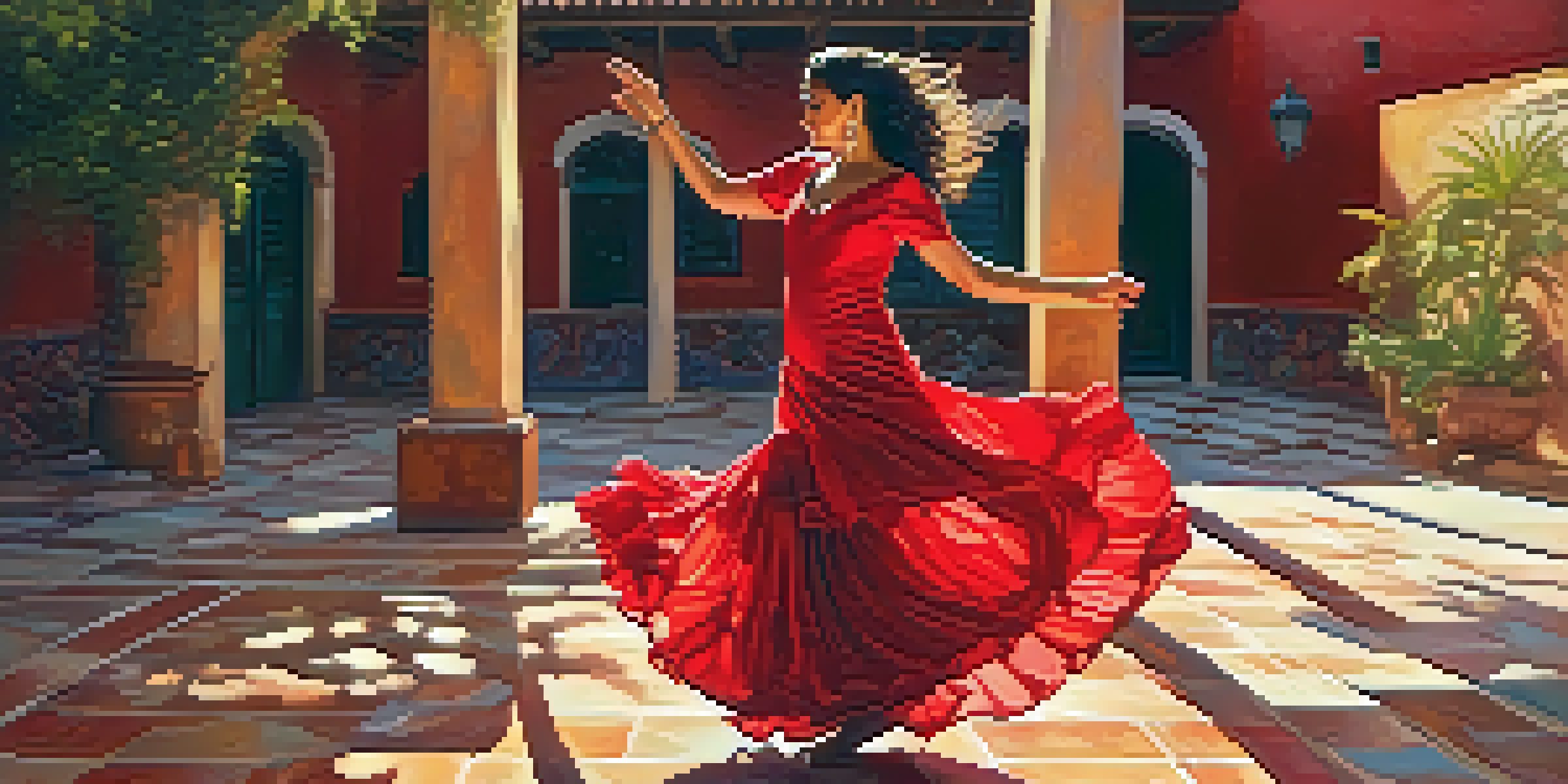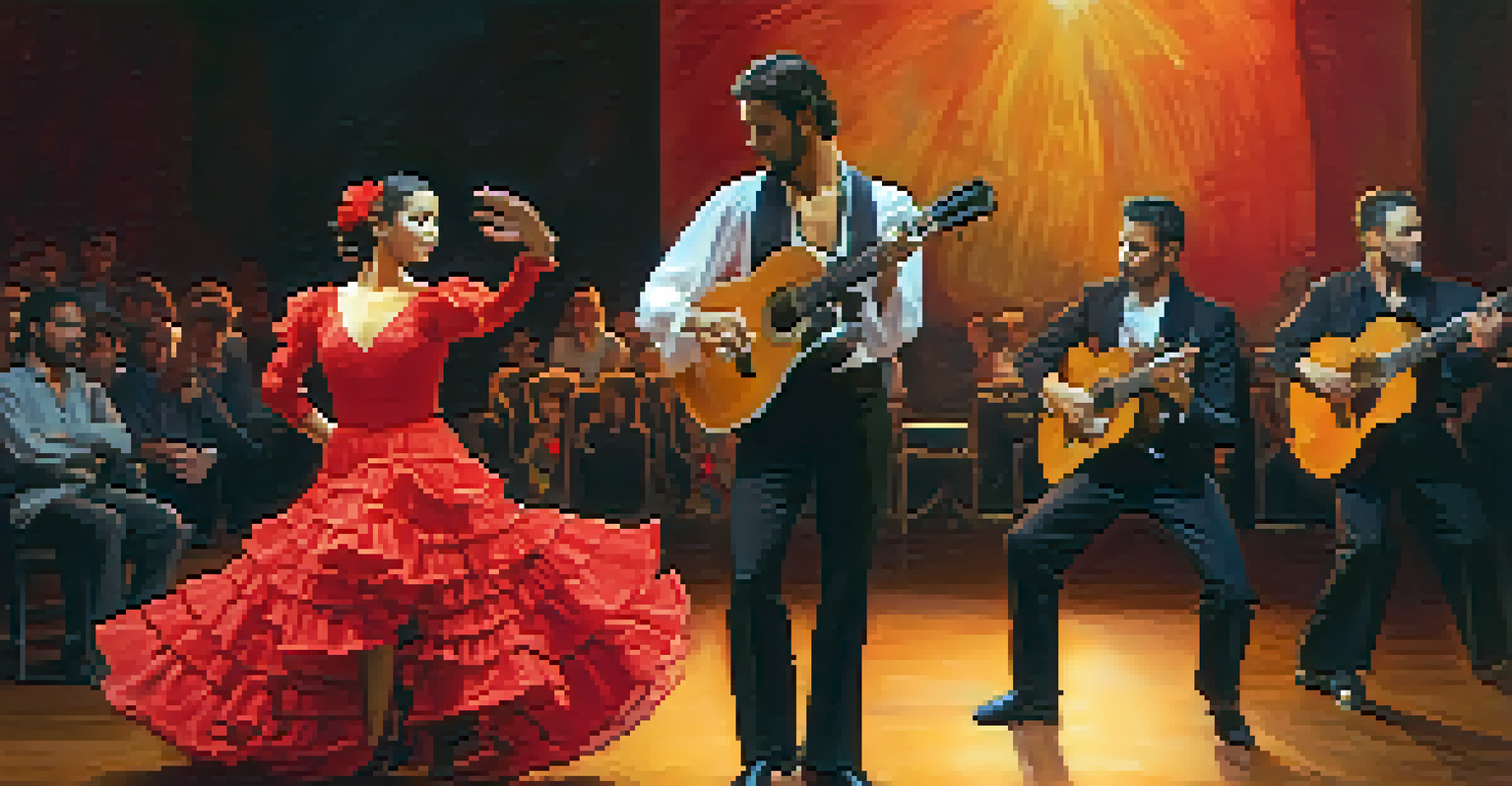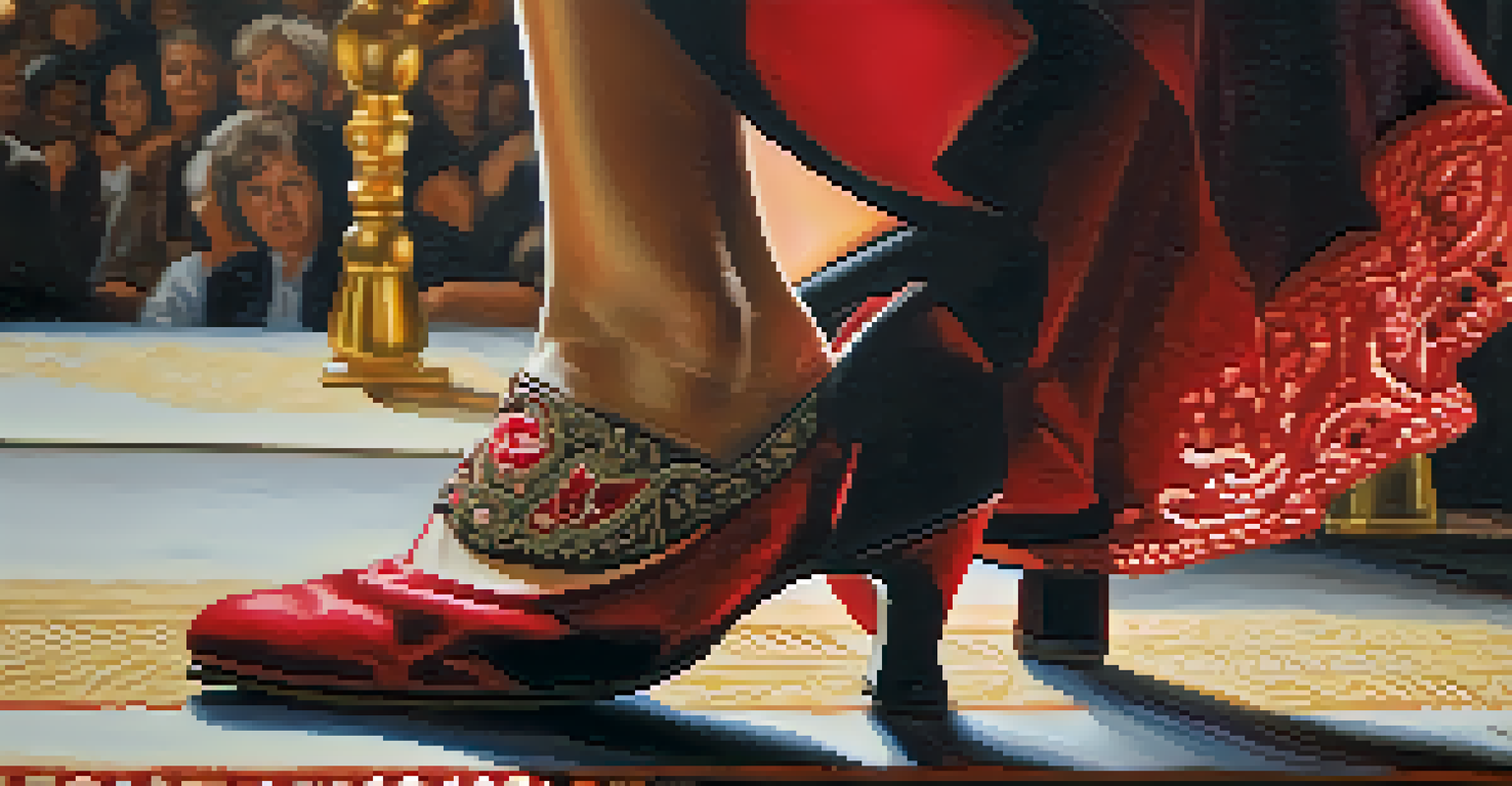The Significance of Flamenco Dance in Spanish Culture

Flamenco: A Rich Tapestry of Tradition and Emotion
Flamenco is more than just a dance; it's a passionate expression rooted deeply in Spanish culture. Originating in the Andalusian region, it combines music, dance, and singing to convey a wide range of emotions, from joy to sorrow. The intricate footwork and expressive movements tell stories that resonate with audiences, making it a powerful cultural artifact.
Flamenco is the sound of the earth, the voice of the people, and the spirit of the culture.
The origins of Flamenco can be traced back to the 18th century, influenced by various cultures, including Gypsy, Moorish, and Jewish heritages. This blend of influences contributes to its unique sound and style, showcasing the diversity of Spanish history. As you watch a Flamenco performance, you can almost feel the heartbeat of Spain pulsing through each step and strum of the guitar.
At its core, Flamenco is about connection—between the dancer, the music, and the audience. This dynamic interaction creates an atmosphere of shared experience, making each performance a one-of-a-kind event. In this way, Flamenco serves as a living tradition, continually evolving while maintaining its cultural significance.
The Role of Flamenco in Spanish Identity
Flamenco has become a symbol of Spanish national identity, representing the country's rich cultural heritage. It's not just a dance form; it embodies the spirit and soul of the people. Many Spaniards take great pride in Flamenco, viewing it as a reflection of their history and emotions, making it an essential part of the national narrative.

Throughout Spain, Flamenco festivals and competitions celebrate this art form, showcasing local talent and regional styles. These events not only foster community but also attract international attention, drawing tourists eager to experience authentic Flamenco. This global interest has further entrenched Flamenco in the identity of Spain, offering a glimpse into the heart of its culture.
Flamenco: A Cultural Treasure
Flamenco is a passionate expression of Spanish culture that intertwines music, dance, and emotion.
Moreover, Flamenco's popularity has sparked a resurgence of interest in traditional Spanish arts, encouraging younger generations to engage with their cultural roots. As they learn to dance, sing, or play the guitar, they become part of a living legacy, ensuring that Flamenco remains vibrant and relevant in the modern world.
Flamenco Dance Styles: A Diverse Expression of Art
Flamenco is not a monolith; it encompasses various styles or 'palos,' each with its own unique rhythm and mood. From the lively 'alegrías' to the more somber 'soleá,' each style reflects different emotions and stories. This diversity allows dancers to express themselves in myriad ways, making Flamenco a versatile and rich art form.
In Flamenco, the dance is an emotional journey that tells the stories of life itself.
The interplay of music and dance styles is crucial to the Flamenco experience. Musicians, dancers, and singers collaborate closely, creating an electrifying performance that captivates audiences. This synergy is what makes a Flamenco show feel so alive and spontaneous, as artists respond to each other in real-time.
Learning about these different styles adds depth to one's appreciation of Flamenco. Each performance tells a story shaped by its unique characteristics, inviting viewers on a journey through the emotional landscape of Spanish culture. Understanding these nuances enriches the experience, making every show a new adventure.
Flamenco's Influence on Global Dance Forms
Flamenco's impact extends beyond Spain, inspiring dancers and choreographers worldwide. Its distinct movements and rhythms have influenced various dance styles, from contemporary to ballet, showcasing its adaptability and universal appeal. This cross-pollination of ideas highlights how Flamenco transcends cultural boundaries, resonating with people everywhere.
Many dance companies incorporate Flamenco techniques into their routines, acknowledging its emotional depth and technical precision. This fusion leads to innovative performances that blend traditional Flamenco with modern dance elements, creating fresh and exciting interpretations. Such collaborations enrich the global dance landscape, demonstrating the versatility of Flamenco.
Flamenco's Global Influence
Flamenco has inspired and influenced various dance forms worldwide, showcasing its adaptability and universal appeal.
Moreover, Flamenco has been recognized by UNESCO as an Intangible Cultural Heritage of Humanity, which further cements its status on the international stage. This recognition not only elevates the art form but also encourages preservation efforts to ensure that Flamenco continues to thrive for future generations.
The Social and Cultural Context of Flamenco
Flamenco is deeply intertwined with the social fabric of Spain, often performed at family gatherings, celebrations, and community events. These informal settings foster a sense of belonging and connection, making Flamenco a communal activity that brings people together. It serves as a reminder of the importance of community in Spanish culture, where shared experiences are cherished.
Furthermore, the themes explored in Flamenco often reflect societal issues, such as love, loss, and struggle. Dancers and musicians draw on their personal experiences, infusing their performances with authenticity and depth. This connection to real-life emotions makes Flamenco relatable, allowing audiences to resonate with the stories being told.
As a living art form, Flamenco continues to evolve, responding to contemporary issues while remaining rooted in tradition. This adaptability ensures that it stays relevant, capturing the complexities of modern life while honoring its rich history. It’s this balance of tradition and innovation that keeps Flamenco alive and thriving.
Flamenco Education: Preserving the Art Form
Education is crucial for the preservation and evolution of Flamenco. Numerous schools and workshops across Spain and beyond teach aspiring dancers, singers, and musicians the intricacies of this art form. These educational initiatives not only pass down technical skills but also instill a sense of cultural pride in students.
Learning Flamenco involves understanding its history, music, and various styles, offering a holistic approach to the art. Many schools emphasize the importance of improvisation, encouraging students to express their individuality while respecting traditional forms. This blend of structure and creativity fosters a new generation of artists who are well-versed in Flamenco's rich heritage.
Preserving Flamenco Through Education
Education plays a vital role in preserving Flamenco, fostering cultural pride and ensuring the art form's evolution.
Additionally, many professional Flamenco artists actively participate in teaching, ensuring that their knowledge and passion are shared with others. This mentorship model helps maintain high standards in Flamenco education, creating a supportive community that nurtures talent. As a result, Flamenco continues to flourish, adapting to contemporary influences while honoring its roots.
The Future of Flamenco in a Modern World
As we move further into the 21st century, Flamenco faces both challenges and opportunities. Globalization and technological advancements have transformed how art is consumed and performed, prompting Flamenco artists to adapt to changing landscapes. This evolution is crucial for keeping Flamenco relevant in a rapidly shifting world.
Many contemporary Flamenco performers explore innovative ways to blend traditional elements with modern influences, creating hybrid performances that attract new audiences. This fusion of styles can enhance the appeal of Flamenco, encouraging younger generations to engage with this rich cultural tradition. The result is a dynamic art form that continues to evolve while honoring its past.

Ultimately, the future of Flamenco lies in its ability to resonate with people across generations and cultures. As artists push boundaries and explore new avenues of expression, Flamenco will likely remain a vibrant and significant part of Spanish culture. Embracing change while respecting tradition will ensure that Flamenco continues to thrive, captivating audiences for years to come.